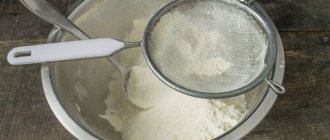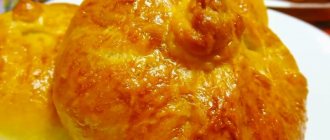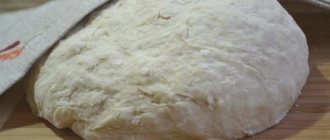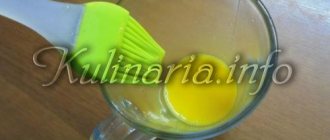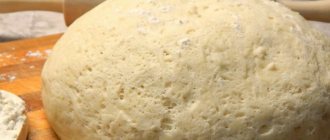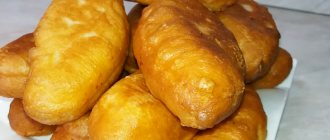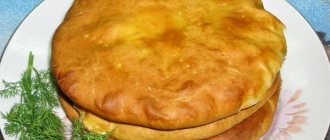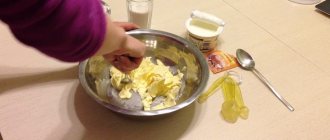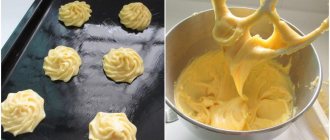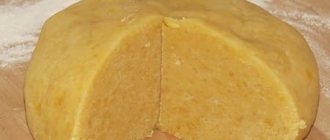1 kg
1 hour 30 minutes
3.67/5 (3)
- Ingredients
- Ingredients
Many housewives are afraid of pies and buns because they are not sure that they will be able to knead the correct and airy dough. I offer you recipes that I use myself, and they have never let me down. I will also tell you in detail how to make airy and tasty yeast dough for all kinds of pies, pies, buns and other baked goods.
Pies “Air”
Long kneading often leaves you with tired hands, and the result is not always close to the desired one. Making tasty and airy dough is quite simple if you know the universal recipe. To create air pies you will need:
- kg flour;
- half a liter of water;
- 2 tablespoons sugar;
- a teaspoon of salt;
- 50-100 ml vegetable oil.
Pour yeast (10-15 g) into the water, stir until completely dissolved, add salt and sugar. Sift the flour twice to make the dough more airy, gradually add two cups at a time to the mixture. After a couple of minutes of stirring, you need to add the oil, stir for another minute with a spoon, and then do it by hand.
It’s important to get your bearings here and if the dough is too liquid, add another glass of flour (this can happen due to different varieties or the “honesty” of manufacturers). After turning into an elastic and springy dough, place it in a bowl, cover with a lid, and place in a warm place for one hour.
During this time, you can calmly and without unnecessary haste prepare the filling for future pies. This dough has two distinctive features: excellent taste and fluffiness, despite the absence of sour cream and dairy products in the composition, as well as versatility - you can use it to make sweet, salty or sour pies with cabbage, fish, etc.
The airy dough will not only pleasantly surprise the whole family, but will also save a lot of effort when preparing. It will take no more than 20 minutes for a full batch, and thanks to their fluffy structure, the pies themselves will bake much faster. In addition, it debunks the established stereotype that yeast dough is difficult to prepare.
Common mistakes when preparing baked goods from puffed dough
- If the mass becomes blurry when deposited, it means the whites were poorly beaten or poorly separated from the yolks; Perhaps the dishes were dirty or greasy, or there was a lot of sugar in the dough.
- If the baked goods are dark in color, it means the baking temperature was high.
- If the baked goods shrink, it means the baking temperature was high or the baked goods were taken out of the oven early.
To the top of the page
ATTENTION! The information presented on this site is for reference only. We are not responsible for possible negative consequences of self-medication!
Airy yeast dough (universal)
For housewives who are not quite “friendly” with yeast baking, there is a recipe that always works. There is no need to make a dough here. Dilute 50 g of yeast with sugar (3 tbsp) until liquid and add an egg, 100 g of vegetable oil and 250 liquid (milk or water), salt. Start kneading until soft. Coat the finished product with flour and cover with a towel. Place the bowl in the refrigerator for 1.5-2 hours. There it will increase 2-3 times and will be suitable for making pies.
How to make dough like fluff
To knead soft, airy dough, the housewife should listen to the recommendations of experienced professionals. First you need to choose the right products. You will need premium wheat flour, high-fat kefir or milk, yeast or soda, vegetable or butter, sugar and salt. There are special requirements for yeast and milk: they must be very fresh.
There are two varieties of delicious dough that resembles fluff - yeast and yeast-free. The latter cooks faster, saves the housewife’s time and is suitable for fried pies. At its base, I replace yeast with soda, and sometimes add rich country cottage cheese for tenderness. The flour must be sifted to give airiness to the baked goods. First the dry ingredients are mixed, and then the liquid ones. The dry mixture is gradually added to the liquid mixture to avoid the formation of lumps. The dough turns out elastic, does not stick to your palms and really resembles soft fluff.
To bake pies, buns or buns in the oven, it is optimal to prepare yeast dough with kefir or milk. For the base, it is better to take kefir of medium fat content; fresh or slightly aged will do. Warm the drink to room temperature in advance so that the yeast and baking powder in it are better activated. A cold product will not allow yeast fungi to loosen the product, and it will turn out tough and unsuitable for baking.
The yeast dough is kneaded on dough, which must be allowed to rise twice, increase in volume, and then rolled out and formed into pies. The products can be baked in the oven or fried in a frying pan. Both processes differ in time - frying takes about 10 minutes, while baking on a baking sheet or in a special form takes up to half an hour for portioned buns and up to an hour for large pies.
Sweet pies
For lovers of sweet and airy baked goods, the following recipe will be useful:
- milk - 250 ml;
- flour - 450-500 g;
- sugar - 160 g;
- vanillin salt - 15 g;
- eggs - 2 pcs.;
- butter - 100 g;
- sunflower oil - ½ tbsp. spoons.
We dilute 12 g of yeast and ½ sugar in milk, add 6-7 tablespoons of flour. Let the dough sit and gradually add the remaining ingredients. After kneading the tender dough, let it rise in a warm place - it will increase 2-3 times. If desired, you can add raisins, dried apricots or nuts.
Lesson No. 7 from 04/14/2020. Routing
Preparation of protein-air dough
Instructional and technological map
Material and technical equipment:
equipment: beater, electric bakery cabinet;
tools, equipment and utensils: pastry sheets, pastry bags with tips, sieves for sugar, knives, scales, production table, pots of various capacities, spoons.
Raw materials: granulated sugar, eggs (whites), vanilla powder.
From the history of the appearance of protein-air dough
In 1720, an unknown Swedish confectioner first beat egg whites with sugar and created meringue.
At the end of the 19th century. confectionery products made from protein-air dough reached the heights of sophistication in the hands of the legendary pastry chef Antonin Karem. He prepared unusual confectionery products for the festive tables of the nobility. In the days of temples, mills and palaces, these small tower works were more architecture than culinary. Such lush buildings should be in fashion, and, fortunately, the tradition of beautiful art continues in coffee shops and confectionery stores, and confectioners from many countries are contributing to the technology of protein-air semi-finished products: France, Sweden, Italy, Russia, etc.
Confectioners in many countries are expanding their range and changing cooking technology, so there is a wide variety of recipes, but the basis of all is sugar and egg white.
Technological operational process
Operation No. 1. Organization of the workplace.
Operation No. 2. Preparation of raw materials for production.
Operation No. 3. Preparing the dough. Carefully separate the yolk from the white; cool them for better whipping.
Operation No. 4. Whipping. Beat egg whites until volume increases 5.6 times. Without stopping whipping, gradually add sugar, vanilla powder and citric acid, continue beating for another 1.2 minutes, no more.
Operation No. 5. Jigging or molding. For cakes, the mass obtained as a result of whipping is placed in a pastry bag with a smooth nozzle or a serrated tube and placed on a pastry sheet greased with oil and dusted with flour or lined with paper. For cakes, blanks are formed using templates using frames or rings in a layer 8-10 mm thick.
Operation No. 6. Baking. Blanks for cakes are baked at a temperature of 100.110°C for about 1 hour, for cakes - for 40 minutes.
Technological map for preparing 10 kg of protein-puffed semi-finished product
| № p/p | Raw materials | Weight, g |
| 1 | Granulated sugar | 9 458 |
| 2 | Egg whites | 4 729 |
| 3 | Vanilla powder | 47,3 |
| 4 | Citric acid | 47,3 |
| Total | 14281,6 | |
| Exit | 10 000 |
Quality requirements. White color; the semi-finished product is fragile, crumbly, and large-porous.
Types of defects in semi-finished protein-puffed products and the reasons for their occurrence
| Types of marriage | Causes |
| The mass spreads out when deposited | When beating whites, the technological regime was not maintained. There were traces of fat, excess sugar in the dough |
| Semi-finished product of dark color | High baking temperature |
| The semi-finished product settles after baking | Insufficient baking time |
| Semi-finished product raw inside (elm kayamassa) | Low baking temperature, should be dried |
Preparation of products from air-protein dough
Divide the sugar into two parts, beat the cooled whites with a mixer at low speed for 2.3 minutes, then at high speed until a fluffy stable mass is obtained, increased in volume by 5.7 times. When whipping, gradually add 50% granulated sugar in small portions, add the remaining 50% granulated sugar, vanilla powder into the whipped mass and mix gently and slowly.
Technological map for preparing Meringue cookies
| № p/p | Raw materials | Weight, g |
| 1 | Granulated sugar | 192 |
| 2 | Egg whites | 72 |
| 3 | Vanilla powder | 1 |
| Total | 265 | |
| Exit | 200 |
Quality requirements.
Appearance - round or oval shape, the pattern is preserved, the surface is convex without cracks;
White color
taste - sweet;
smell - vanillin;
consistency : dry, brittle;
humidity — 3,5%.
Assortment of semi-finished products from protein-air dough
To obtain the main protein-air semi-finished product, egg whites are beaten, saturated with air and turned into a hard foamy mass. Adding sugar makes this mass even more rigid, which is necessary for it to maintain its shape on the baking sheet. This light, airy mixture bakes for a long time until it is dry and crispy.
Three types of meringue - French, Italian and Swedish - have special properties.
French meringue
First beat the whites, then gradually add sugar. This meringue is most suitable for simple shapes, which after baking become small meringues for filling and decoration.
Italian meringue
Sugar is added to the proteins in the form of boiling syrup. This method of combining partially cooked ingredients without further baking is used for light mousses and buttercreams. Italian meringue is also ideal for decorative surfaces of other baked goods that need a little time in the oven to decorate.
Swedish meringue
made by beating egg whites and sugar over boiling water. This produces a thick mass that is suitable for complex meringues and ornate decorations.
Whatever air-white mixture you make, not a drop of yolk should get into the whites, which will prevent the whites from rising completely.
The dishes should be glass or porcelain so that fat does not stick to them. Copper cookware is best because copper reacts well with egg whites, which helps create a stiff foam.
French meringue should be baked immediately after cooking because it easily absorbs moisture and begins to fall off. Italian and Swedish meringues are left to sit for several hours before eating to allow them to develop a crust.
Meringue
Meringue is an airy product that goes well with almost any filling and decoration.
Baking is more like drying. Meringue mixture combined with chopped or ground chocolate forms a separate subgroup known as Japanese meringue. Nut meringue is baked at a higher temperature, at which it becomes a thin, crispy cake with a slight viscosity in the center. Japanese meringue combined with butter cream is the basis for the most interesting creations in confectionery. A sweet swirl of strawberries and cream. Sprinkling with sugar adds a crunchy sensation.
When making Italian meringues, fruit juice or soft fruit puree is added to the sugar syrup. Chopped nuts added to the main meringue mixture not only improve the taste, but also change the texture of the final product. Known by their French name as japone, they are crispy and firm on the outside and chewy on the inside. Use almonds or hazelnuts. You can combine two types of nuts. The nut filling will perfectly complement the japone.
Meringue
Meringue is an airy confectionery product that requires only whipped egg whites and sugar.
Basic meringue recipe
Products for 12 pcs. meringue cookies: '/ 4 l egg white (from about 8 eggs), 200 g granulated sugar, 150 g caster sugar, 30 g potato starch.
Cooking sequence:
beat the whites into a stiff foam. While beating, add granulated sugar;
sift the powdered sugar mixed with potato starch, pour into the beaten egg whites and mix carefully with a wooden spoon;
transfer the resulting mass into a pastry bag and place it through a tube with a large star-shaped hole onto a baking sheet of the meringue shape specified in the recipe; The baking sheet on which the meringue is baked (or rather, dried) must be covered with parchment. On the parchment, you can first, at certain intervals, mark with a pencil the contours of the cookies that need to be placed;
Preheat the oven (oven) to a temperature of 100 °C, place the baking sheet on a medium level, dry the meringue for 8 hours. The oven (cabinet) door must be kept ajar;
Curly meringues in the form of baskets, rosettes, filled with whipped cream, berries or ice cream are very popular.
To prepare the meringue cake, line a baking sheet with parchment and trace a round shape on it. Release the whipped egg white mass into this outline onto the parchment from the pastry bag.
Nut meringue
The nut meringue is prepared in full accordance with the basic recipe, but another 150 g of peeled ground walnuts or hazelnuts are added to the protein mass whipped with potato starch.
Chocolate meringue
Protein-air dough in the form of a white, light, fluffy foamy mass is prepared with or without flour (classic recipe), in some cases nuts, cocoa powder, and dyes are added.
Technological map for preparing 10 kg of semi-finished puffed nut product
| № p/p | Raw materials | Weight, g |
| 1 | Granulated sugar | 6 839 |
| 2 | Egg whites | 4103 |
| 3 | Nut kernels (roasted) | 2 906 |
| 4 | Vanilla powder | 85,5 |
| Total | 13 249,5 | |
| Exit | 10000 |
Humidity (3.5+1.5)%
CONTROL QUESTIONS
1. Name the technological operations for preparing air-protein dough.
2. What processes occur when baking air-protein dough?
3. Name the products made from puffed protein dough that you know.
4. What happens to egg whites when they are beaten?
Sour cream dough for pies
Sour cream is a universal ingredient for dough. If there is such a dairy product left in the refrigerator, do not throw it away. Combine butter (125 g) and flour (500 g) until crumbly. Combine 200 g sour cream, 6 tbsp. l. sugar and 25 g of yeast - let it make noise. Then beat in 2 eggs and gradually add the flour crumbs. Leave the resulting base in a warm place until it increases several times.
Fried pies with sour cream
- sour cream - 250 g;
- eggs - 2 pcs.;
- salt - tsp;
- sugar - 2 tbsp. spoons;
- baking soda - tsp;
- vinegar or lemon juice - 3-5 drops.
Add soda and vinegar to the sour cream and let it make some noise. Then mix in the remaining products, sift 400 g of flour. You will get an elastic dough that is suitable for any filling.
Continuation…
Thin country-style Lapti pies: Recipes with any filling and fluffy dough, useful tricks
Even spoiled kefir will work for the test. “Lapti” pies on curd dough, fried and baked, with potatoes, cabbage and meat. Recipe for Voronezh bast pies.
